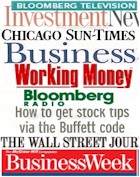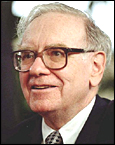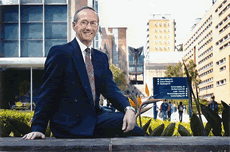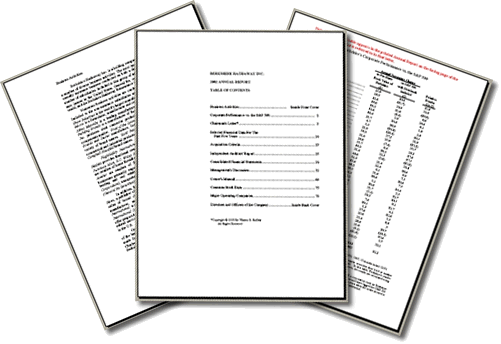| Inspired by the world’s
greatest investor, Warren Buffett
| Warren Buffett |
|
The Conscious
Investing story begins with reference to Warren Buffett,
whose uncommonly rational
approach to stock market investing, provided the original
inspiration for the company’s development.
Warren Buffett’s success in the
stock market is unmatched. He is the Chairman and CEO
of Berkshire Hathaway, a diversified investment company
valued at over US$140 billion. Before that Buffett
ran private investment partnerships.
Suppose someone had the good sense to
invest US$10,000 in one of Buffett’s original
partnerships back in 1956 when they first started.
And suppose that |
when the partnerships terminated in 1969,
this person reinvested the proceeds in Berkshire Hathaway.
Today that person would be worth over US$280 million—after
all taxes and expenses.
An
Obsessive Crusade
For more than a decade, Professor John Price
has had two goals. The first was to understand how Buffett
invests. The second was to develop a system that allows
any investor to implement these strategies successfully.
|
John
Price was featured in The Australian's "True
Confessions" column.
[Read
the article]. |
John
had developed a suite of computer tools for himself
to implement Buffett’s methods in a systematic
way. He tested them thoroughly with his own investing,
through bull and bear markets alike. When John used
the tools he found that every time the investment was
successful. In contrast, when he used the standard methods,
the results were mixed. The worst investments were when
he hurriedly followed the advice of people who were
acknowledged as “experts”, instead of relying
upon his own research and findings. |
Of course this process of trial and error
itself is often an important part of the process of learning
to invest successfully. Buffett has said about his investing
before he read Benjamin Graham’s book The Intelligent
Investor. “I went the whole gamut,” he
explained. “I collected charts and I read all the
technical stuff. I listened to tips. And then I picked up
Graham’s The Intelligent Investor. That was
like seeing the light.”
Later Buffett added, “Prior to that,
I had been investing with my glands instead of my head.”
Conscious Investing is laser-focused on what
was thought to be an impossible mission … making
Warren Buffett's brilliant investing strategies available
to ordinary, everyday investors.
Most significantly, however, Conscious Investor
overcomes the main objection that most “DIY-Buffetteers”
have which is in relation to calculating “what price
to pay” for a stock.
Buffett’s Secrecy
One of the problems of trying to unpack Buffett’s
methods was his secrecy.
Even though Buffett writes and speaks a great
deal about his methods, it is always in general terms. He
doesn’t reveal what stocks he is buying or selling
unless it is required by SEC legislation. The reason for
this is simple. He does not want to give any advantage to
other investors. Each year he writes in the Annual Report
of Berkshire Hathaway:
“Despite
our policy of candor, we will discuss our activities
in marketable securities only to the extent legally
required. Good investment ideas are rare, valuable
and subject to competitive appropriation just as good
product or business acquisitions are.” |
Buffett is also secretive about his investment
methods. He often says that he freely discusses them. When
you start reading his reports and interviews, it looks like
this is the case. (Berkshire
Hathaway Annual General Report)
Everything would start well
with Buffett giving brilliant descriptions of his general
principles. But when you needed something that was detailed
enough to apply to the evaluation of a specific company,
you would find one of two things. Either there was insufficient
information or the information led you in the wrong direction.
Let’s give you two examples: intrinsic
value and return on equity.
In the essay An
Owner’s Manual for Berkshire Hathaway,
Buffett writes, “intrinsic value … is the only
logical approach to evaluating the relative attractiveness
of investments and businesses.” This is a good start
and it gets better. He says that intrinsic value can be
defined simply as “the discounted value of the cash
that can be taken out of a business during its remaining
life.” Now we are getting somewhere.
The next paragraph says that the calculation
of intrinsic value is not so simple and different people
will arrive at different figures. I can live with that.
All I want to know is how W.B. does it. Unfortunately we
don’t get this. Nor do we get any further indication
of how it is done. He closes the paragraph by saying that
“we never give you our estimates of intrinsic value
[although] our annual reports do supply the facts that we
ourselves use to calculate this value.” This tells
us nothing. The annual reports of Berkshire Hathaway are
in the same general form as the reports of any other company
with the financial sections occupying many pages of dense
financial information.
We are left with more questions than we started
with. For example, just what is the “cash that can
be taken out of a business?” For example, is it earnings,
or cash flow, or cash earnings, or free cash flow, or owner
earnings, or something else? And how do we estimate its
size for future years.
Instead of stumbling around with all the different
types of value models, we realized that these difficulties
could be bypassed by providing techniques for estimating
the actual return you will get with your investments. The
idea was that it does not matter what the theoretical value
of the stock is. What counts is that you can be confident
that it will rise in price so that you can get the return
you expect from it within your investment time frame.
This was reinforced by another quote from Buffett stating that he only invests when he is confident of making a return of at least 10 percent after tax. This is why Conscious Investor focuses on the method of calculating the expected return.
Continuing with the problem of insufficient
detail, regarding the second example, return on equity,
every book and commentator on Buffett’s methods says
that he bases his analyses on this figure. We came to the
same conclusion. But when we went to apply return on equity
in practical situations, sometimes the analyses made sense
and sometimes they did not.
So then we went back and re-read everything
Buffett had written. Gradually clues began to emerge that
he does not use return on equity … he uses return
on capital! Suddenly all the pages of analyses and company
studies made sense. It became clear in some cases return
on equity is better to use, and in other cases return on
capital is better. But that wherever possible look at return
on capital.
Professor Price's painstaking research, conducted
tirelessly over a full decade, has now produced a software
system that allows the private and professional to select
quality companies. Those rare few businesses with low debt,
high return on equity and capital, products and services that stand
out from their competitors and that have competent management
with a long track record in their industry.
|






